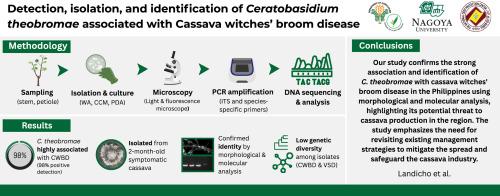菲律宾木薯丛枝病相关可可根丝核菌的检测、分离和鉴定
IF 3.3
3区 农林科学
Q2 PLANT SCIENCES
引用次数: 0
摘要
木薯(Manihot esculenta Crantz)是包括菲律宾在内的热带地区重要的粮食安全根茎作物。然而,木薯的生产日益受到木薯女巫扫帚病的威胁。本研究检测、分离并鉴定了一种新的木薯伴生真菌——可可根瘤菌(Ceratobasidium theobromae)。在2017年至2022年期间收集的97份有症状的木薯样本中,有96份检测到可可分枝杆菌。菌丝呈白色至淡黄色,呈棉质状,分枝呈直角状,孢子中隔呈水珠状,菌丝呈念珠状,具有丝核菌/角孢霉的典型特征。虽然在作物早期(种植后2个月)成功分离,但由于真菌生长不良,随后的继代培养失败,因此很难通过接种再现症状并实现科赫假设。内部转录间隔区和28S大亚基核糖体RNA基因的序列分析证实了该真菌的同源性,与先前报道的印尼维管条纹枯梢病可可和美国维管条纹枯梢病红芽中分离的可可枯梢病真菌具有99.7 - 100%的相似性,但与老挝、柬埔寨和越南的木薯相关分离株的相似性略低(98.4 - 98.8%)。单倍型多样性分析显示,各分离株的遗传多样性较低(π = 0.0047),表明群体遗传稳定,中性试验结果不显著。这些发现证实了可可霉与菲律宾木薯女巫帚病的密切关联,突出了其对该地区木薯生产的潜在威胁。该研究强调需要重新审视现有的管理战略,以保护木薯产业。本文章由计算机程序翻译,如有差异,请以英文原文为准。

Detection, isolation, and identification of Rhizoctonia theobromae associated with cassava witches’ broom disease in the Philippines
Cassava (Manihot esculenta Crantz) is an important food security root crop in the tropics, including the Philippines. However, its production is increasingly threatened by the Cassava witches' broom disease. This study detected, isolated, and identified Rhizoctonia theobromae (syn. Ceratobasidium theobromae), a newly associated fungus of cassava. Species-specific PCR detected R. theobromae in 96 out of 97 symptomatic cassava samples collected between 2017 and 2022. Morphological characterization of isolates revealed cottony white to yellowish mycelia, right-angled branching, dolipore septa, and monilioid hyphae, features typical of Rhizoctonia/Ceratobasidium. Although successful isolation was achieved during early crop stage (2 months after planting), subsequent subculturing was unsuccessful due to poor fungal growth, thus reproducing symptoms via inoculation and fulfilling Koch's postulate were difficult. Sequence analysis of the internal transcribed spacer region and the 28S large subunit ribosomal RNA gene confirmed the identity of the fungus, showing 99.7–100 % similarity to previously reported R. theobromae isolates from vascular streak dieback-diseased cacao in Indonesia and vascular streak dieback-diseased redbud in the United States, but slightly lower similarity (98.4–98.8 %) to those cassava-associated isolates in Laos, Cambodia, and Vietnam. Haplotype diversity analysis revealed low genetic diversity among isolates (π = 0.0047), suggesting a genetically stable population and neutrality tests showed no significant results. These findings confirm the strong association of R. theobromae with cassava witches' broom disease in the Philippines, highlighting its potential threat to cassava production in the region. The study emphasizes the need for revisiting existing management strategies to safeguard the cassava industry.
求助全文
通过发布文献求助,成功后即可免费获取论文全文。
去求助
来源期刊
CiteScore
4.30
自引率
7.40%
发文量
130
审稿时长
38 days
期刊介绍:
Physiological and Molecular Plant Pathology provides an International forum for original research papers, reviews, and commentaries on all aspects of the molecular biology, biochemistry, physiology, histology and cytology, genetics and evolution of plant-microbe interactions.
Papers on all kinds of infective pathogen, including viruses, prokaryotes, fungi, and nematodes, as well as mutualistic organisms such as Rhizobium and mycorrhyzal fungi, are acceptable as long as they have a bearing on the interaction between pathogen and plant.

 求助内容:
求助内容: 应助结果提醒方式:
应助结果提醒方式:


